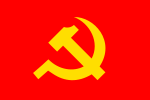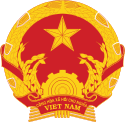Communist Party of Vietnam
| Communist Party of Vietnam | |
 |
|
| Founded | February 3, 1930 |
|---|---|
| Headquarters | Ba Đình district, Hà Nội |
| Newspaper | Nhân Dân |
| Ideology | Communism (official), Socialism (official) Marxism-Leninism (official), Ho Chi Minh's Thought (official) |
| Website | |
| Communist Party of Vietnam Online Newspaper | |
| Vietnam |
 This article is part of the series: |
|
|
|
|
Other countries · Atlas |
The Communist Party of Vietnam (Đảng Cộng sản Việt Nam) is the currently ruling, as well as the only legal political party in Vietnam. It is a Marxist-Leninist Communist Party supported by (and a part of) the Vietnamese Fatherland Front. In most of the cases, the Vietnamese press and people refer to the Communist Party of Vietnam as "Đảng" (Party) or "Đảng ta" (our Party).
Contents |
History
The Party was founded by Hồ Chí Minh and other exiles living in China as the Vietnamese Communist Party (Việt Nam cộng sản Đảng) at a conference in Hong Kong February 1930.[1] At the Hong Kong conference two competing communist factions, Indochinese Communist Party (Đông Dương cộng sản đảng) and the Communist Party of Annam (An Nam cộng sản Đảng), merged. Although the third Vietnamese communist group, the Indochinese Communist League (Đông Dương cộng sản liên đoàn), had not been invited to the Hong Kong conference its members were allowed to become members of the new united party.
The Hong Kong conference (held in Kowloon City) elected a nine-member Provisional Central Committee, consisting of 3 members from Tonkin, 2 from Annam, 2 from Cochinchina, and 2 from the overseas Chinese community.[2] The latter group had previously been organized within the South Seas Communist Party.
Soon thereafter, at its first plenum the party changed its name to the Indochinese Communist Party (Đảng cộng sản Đông Dương), on directions from Comintern.[2]
The First National Party Congress was held in secret in Macau in 1935. At the same time, a Comintern congress in Moscow adopted a policy towards a popular front against fascism and directed Communist movements around the world to collaborate with anti-fascist forces regardless of their orientation towards socialism. This required the ICP to regard all nationalist parties in Indochina as potential allies.
The party was formally dissolved in 1945 in order to hide its Communist affiliation and its activities were folded into the Marxism Research Association and the Viet Minh, which had been founded four years earlier as a common front for national liberation. The Party was refounded as the Vietnam Workers' Party (Đảng lao động Việt Nam) at the Second National Party Congress in Tuyen Quang in 1951. The Congress was held in territory in north Vietnam controlled by the Viet Minh during the First Indochina War. The Third National Congress, held in Hanoi in 1960 formalized the tasks of constructing socialism in what was by then North Vietnam, or the Democratic Republic of Vietnam (DRV) and committed the party to carrying out the revolution of liberation in the South. At the Fourth National Party Congress held in 1976 after the end of Vietnam War with the reunification of Vietnam, the Party's name was changed to the Communist Party of Vietnam.
Organization
The CPV is a Marxist-Leninist party run on democratic centralist lines. The supreme leading body is the Politburo (Political Bureau) headed by the Secretary-General. The Politburo is elected by the Central Committee, and the Central Committee is elected by the National Congress. In 1976, as a result of the unification of North and South Vietnam, the Central Committee was expanded to 133 members from 77 and the Politburo grew from 11 to 17 members while the Secretariat increased from seven to nine members.
Membership in the party doubled from 760,000 in 1966 to 1,553,500 in 1976, representing 3.1 percent of the total population of the country, and was close to two million by 1986.
The title President of the Central Committee, existing during 1951 - 1969, was nominated for Ho Chi Minh. This position is considered to be that of the supreme leader of the Party.
The National Congress of CPV is to be held every five years (since 1976). Due to the war footing during the wars against French and U.S. troops, the first 4 congresses were not fixed to the common time schedule. After the Foundation Conference, 10 national congresses of CPV have been held.
- 1st Congress, Macau (currently China, then a Portuguese colony), 1935
- 2nd Congress, Tuyen Quang, 1951
- 3rd Congress, Hanoi, 1960
- 4th Congress, Hanoi, 1976
- 5th Congress, Hanoi, 1982
- 6th Congress, Hanoi, 1986
- 7th Congress, Hanoi, 1991
- 8th Congress, Hanoi, 1996
- 9th Congress, Hanoi, 2001
- 10th Congress, Hanoi, 2006
Ten people have held the First Secretary (1960-1976) and/or General Secretary (1930-1960 and 1976-Present) positions of the CPV, namely:
- Trần Phú (1930-1931)
- Lê Hồng Phong (1935-1936)
- Hà Huy Tập (1936-1938)
- Nguyễn Văn Cừ (1938-1940)
- Trường Chinh (1941-1956 and 1986)
- Lê Duẩn (1960-1986)
- Nguyễn Văn Linh (1986-1991)
- Đỗ Mười (1991-1997)
- Lê Khả Phiêu (1997-2001)
- Nông Đức Mạnh (2001- present).
At the Sixth National Party Congress, held in December 1986, Nguyen Van Linh was elected to be the General Secretary while a Politburo of fourteen members was elected and the Central Committee was expanded to 173 members.
At the Ninth National Party Congress in 2001, Nong Duc Manh became the new Secretary-General. He was re-elected for a second term at the Tenth National Party Congress in 2006.
A Party Congress, comprising 1,176 delegates at the Tenth Party Congress in April 2006, meets every 5 years to set the direction of the party and the government. The 160-member Central Committee, which is elected by the Party Congress, usually meets at least twice a year, with the Politburo meeting more frequently and the Secretariat being responsible for day to day activities under the direction of the Secretary-General.
The present 14-member Politburo, elected in April 2006, determines government policy, and its eight-person Secretariat oversees day-to-day policy implementation. Although there has been some effort to discourage membership in overlapping party and state positions, this practice continues. The Party's Central Military Commission, which is composed of select Politburo members and additional military leaders, determines military policy.
The Party's current Politburo lineup, approved by the Central Committee in April 2006, is as follows:
- Nông Đức Mạnh, Party's Secretary-General
- Lê Hồng Anh (General), Minister of Public Security
- Nguyễn Minh Triết, Secretary of the Ho Chi Minh City Municipal Party Committee (now President of the Socialist Republic of Vietnam)
- Nguyễn Tấn Dũng, Deputy Prime Minister (now Prime Minister of the Socialist Republic of Vietnam)
- Truong Tan Sang, Head of the Party's Central Committee's Commission of Economic Affairs (now Standing Member of the Central Committee's Secretariat of the Party)
- Nguyen Phu Trong, Secretary of the Hanoi City Municipal Party Committee (now Chairman of the National Assembly)
- Phạm Gia Khiêm, Deputy Prime Minister
- Pham Quang Nghi, Minister of Culture and Information (now Secretary of Ha Noi Municipal Party Committee, replacing Trọng)
- Nguyen Sinh Hung, Minister of Finance (now Deputy Prime Minister)
- Nguyen Van Chi, Head of the Party's Central Committee's Commission of Inspection (now concurrently Secretary of the Party's Central Committee)
- Ho Duc Viet, Chairman of the National Assembly’s Committee for Science, Technology and Environment (now Head of the Party's Central Committee's Commission of Organizational Affairs)
- Phung Quang Thanh, Senior Lieutenant-General, Deputy Minister of Defense (now Minister of Defense)
- Truong Vinh Trong, Head of the Party's Central Committee's Commission of the Interior (now Deputy Prime Minister and Secretary of the Party's Central Committee)
- Le Thanh Hai, Chairman of the Ho Chi Minh City People’s Committee (now Secretary of Ho Chi Minh City Municipal Party Committee, replacing Triết)[3]
The Party's current Secretariat has eight members as follows:
- Nông Đức Mạnh
- Trương Tấn Sang
- Trương Vĩnh Trọng
- Nguyễn Văn Chi
- Hồ Đức Việt
- Lê Văn Dũng
- Tòng Thị Phóng
- Tô Huy Rứa
Ideology
The Communist Party of Vietnam has claimed Marxism-Leninism and Ho Chi Minh Ideology to be ideological basis of the Party and the Revolution. Though formally Marxist-Leninist, the Communist Party of Vietnam has moved towards market reforms in the economy (see also Đổi Mới, the Renewal launched by the Sixth Congress of the Party in 1986) and has permitted a growing mid-level private sector. However, the Party retains a monopoly on power.
See also
- Nhân Dân (The People)
- Tenth National Congress of the Communist Party of Vietnam
- List of Communist Parties
- List of political parties in Vietnam
- List of political parties
References
- ↑ Smith, R.B., 'The Foundation of the Indochinese Communist Party, 1929-1930', Modern Asian Studies, 32,4 (1998), p.799
- ↑ 2.0 2.1 Ho Chi Minh and the Communist Movement
- ↑ Vietnam latest news - Thanh Nien Daily
- ↑ [1]
External links
| Communist Parties |
 |
|
Africa
|
|
Americas
|
|
Asia
|
|
Europe
|
|
Middle East
|
|
Related topics
|
- Official English language web site
- Nhân Dân (The People): the official party newspaper
- The birth of the Communist Party of Vietnam Article recalling the party's founding in 1930. (This page does not currently load.)
|
|||||||||||